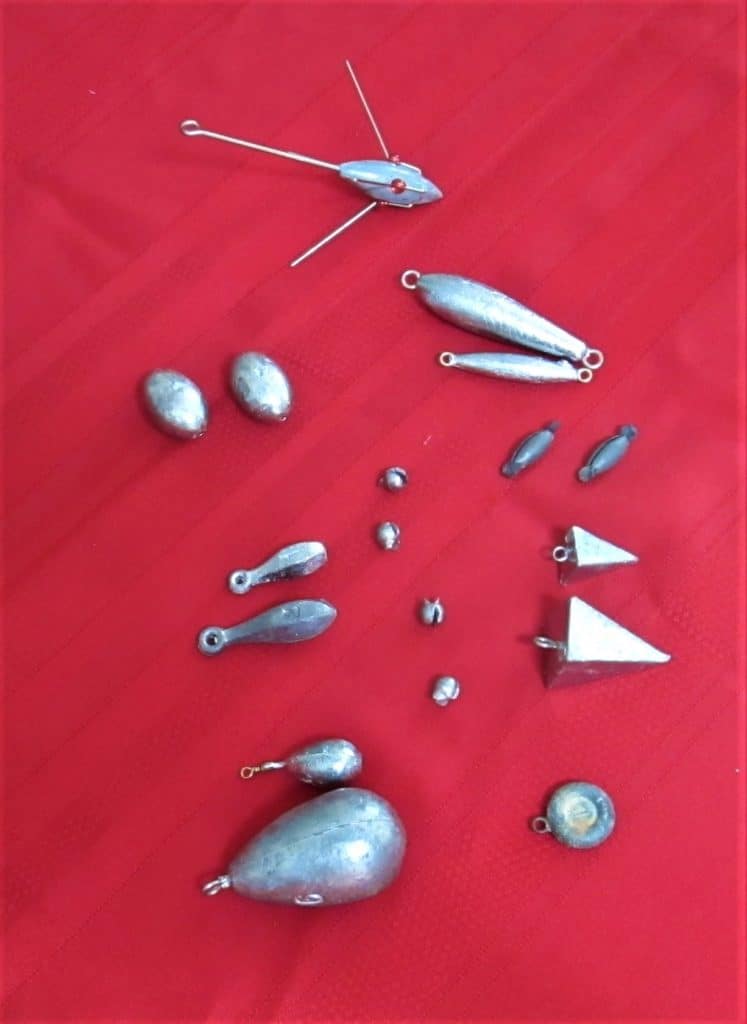Sporting Life

That Sinking Feeling Can Get Complicated
By Dennis Doyle
Some casual anglers may regard fishing sinkers as merely a weighted device to get their baits down on the bottom where the fish live and feed. Other than the weight of the item, they pay little attention to the style they are using. However, there are many designs available these days from bell, bass and bank sinkers to bullet heads, egg sinkers, disc sinkers, rubber cores, split shot, walking sinkers, pencil weights, drop shots, deep drops, pear bombs and a particularly unique design called a sputnik among other current creations. It can sometimes be a distinct advantage to be aware of them.
The most popular type for general Bay angling is the bank sinker. It is a simple, inexpensive, lead casting in multiple weights with the eyelet hole formed into the narrow end of the lead weight with usually four to six flat sides tapering into a heavier, rounded bottom. Named (I’m told) for its most common use—fishing off of convenient banks—it casts well with an aerodynamic shape, and generally holds it place on the bottom in mild currents. A two-ounce size is the most commonly used in Bay waters up to 40 feet or so.
The bell (or dipsey) sinker is the next most used type and available in sizes up to 16 ounces or more. Tear drop-shaped with a copper wire eyelet and shaft running through the center, they cast well and are not intended to hold bottom securely but will roll easily, actually an advantage if you want to present your bait drifting with the current across an area. Its shape minimizes snagging on bottom obstructions and will bounce and bound easily across the bottom. This design along with the in-line sinker are also commonly used in trolling applications to keep lures at desired depths.
When one desires to present a bait holding bottom against a current, the pyramid sinker is a better choice. A three- or four-sided, pointed, pyramid shape with a copper wire eyelet set into a flat top, it is designed to dig into and hold the bottom. The pyramid is also the top choice for surf anglers and an advantage for boat anglers fishing multiple rigs, some rigged with bank sinkers and other with pyramids, to keep them separated in moving currents.
Though a two-ounce bank weight is the most common type and size generally used for chumming and presenting baits in up to 40 feet, as well as for bottom bouncing, drifting and simple bottom fishing the real rule of thumb in deciding how heavy a weight to use is just this: the lightest weight possible that will hold your bait or to present it where you want it. Fish, particularly a larger, older fish, soon learn that anything attached to the morsel of food they are considering is dangerous to their safety. The less the sinker weighs the less noticeable it is.
There are other exceptions and features to these types including sinkers made of tin, brass, steel, bismuth, tungsten, recycled glass and even granite to conform to local environmental efforts but lead sinkers remain the most common and economical form in the angler’s tool box.
As an angler’s pursuits get more focused on specific and newly desirable species that dwell or travel in special or unique marine environments and water depths, baits or lures that tempt those fish are also soon developed. The unique sinker or device that allows the baits or lures to be presented in those specific places are also eventually designed by clever individuals to assist in doing just that. The fisherman’s world can get mighty weird and complicated, especially when they put their mind to it. Enjoy!
Fishfinder:
The rockfish bite is continuing well to the north of the Bay Bridge again this year. There is some action at Love Point and the mouth of the Chester but low oxygen deep around Podickery and south to Hacketts is pushing the schools out. The mouth of the eastern Bay is producing, as is around Poplar Island but you may have to look a little for the fish. The most mobile choice of tactics is to troll medium to small bucktails tipped with Sassy Shad but if you can mark a collection of fish deep, chumming will be effective. Remember to set up in the current above the fish so your slick gets carried to them. Jigging can be effective in these conditions as well. The white perch are well situated up in the tribs now and taking small spinnerbaits such as Capt. Berts and Beetlespins. Catfish are gathering in the deeper parts of tributary mouths and the snakeheads are running up into the lily pads and holding on laydowns and submerged brush along the shores. It’s the summertime bite. Beware of the sun.
